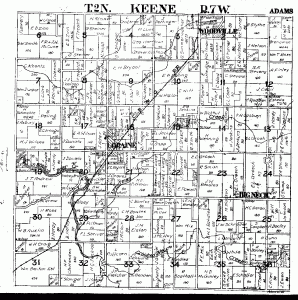This township was first settled about the year 1834. Joel Benton, Thomas Hudson, Ralph Harden and John Caldwell were among the pioneers who commenced the culture of its soil and took advantage of the rich source of revenue furnished by the valuable timber, belts of which interspersed the fine prairies. This township is a valuable stock raising section, more especially because of the fact that it is so well watered. The principal streams are South Fork, Thurman creek, Middle Fork and Big Neck creek.
The first school house in the township was built of logs in 1843, on section 16. The first church organized was of the Methodist Episcopal denomination under the name of “Union Society,” in 1860. They erected a frame church building on section 24. The officers were Granville Bond, pastor; Samuel Curless, class leader and Ezekiel Walters, steward. The church was organized with fifteen members.
The first (fraternal) society organized in Keene township was Loraine lodge, No. 641, I.O.O.F., instituted under dispensation June 20, 1877, by District Deputy James A. Benneson of Robert Brooker lodge, No. 406, of Quincy, in the hall fitted up for the purpose over the store of Christopher Seals. The charter members were David Andrews, John Pollock, Frank Seals, James M. Curless, Christopher Seals and James Coffield. The first officers elected were Christopher Seals, N. G.; James Coffield, V. G.; James W. Curless, secretary, and James M. Seals, treasurer.
The first mill in the township was known as “Seals” Corn Cracker,” built in 1852, on section 21.
The village of Loraine was laid out in December, 1870, by Messrs. Woods and Lionberger, during the construction of the Carthage branch of the Chicago, Burlington & Quincy Railroad. James H. Wade, in 1870, built a store house and began a general merchandising business. In 1871 he was appointed postmaster. Christopher Seals, in the spring of 1871, built a store house and a dwelling, and did a general merchandising business, and also kept a hotel known as the ‘Traveler’s Rest.” S. P. Halton, in the summer of 1871, built a blacksmith shop and a dwelling. Other store houses, dwellings, shops, etc., followed soon. In the spring of 1872 George A. Yenter built a grain house and bought and shipped grain, as well as livestock. The first drug store was built by P. S. Cavilee in the spring of 1873. E. J. Selleck, in the summer of 1873, built a grist mill, which, before its completion, he sold to George Jackson and son. Rust & Barniber, in the spring of 1874, built a blacksmith shop. Drs. Coffield and Akins, in the spring of 1875, built a drug store and office and also practiced medicine, and in August of the same year Dr. Akins was appointed postmaster, and remained in office until January, 1878, after which James Coffield was appointed to the position, which he retained for some years.
All lines of trade incident to a railroad point in the midst of a thriving agricultural and stock raising region has been continued, and the village is in every way calculated to do and to maintain a good business. Woodville, a small place of about fifty inhabitants, is situated on the line of the railroad, in the extreme northern portion of the township. It was laid out in 1836.
Source: Past and present of the city of Quincy and Adams County, Illinois, p. 328-329; by William H. Collins, Cicero F. Perry, joint author; John Tillson. History of the city of Quincy, Illinois. [from old catalog]. Chicago, S. J. Clarke Pub. Co. 1905.


Recent Comments